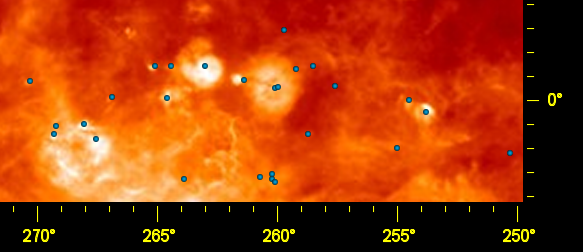
Hover your mouse over each blue dot for the name of the object, or click on the dot for a detail page. This map was created using the all-sky hydrogen-alpha map produced by Douglas Finkbeiner from data collected by the WHAM, VTSS and SHASSA hydrogen-alpha surveys.
Two nebulae in this image appear to be embedded in the Gum nebula. These are the Vela supernova remnant (Gum 16), which is actually the huge bubble in the main image of the Gum nebula, and RCW 33, which appears to be ionised by the star cluster Trumpler 10 (although some sources associate RCW 33 with the region around RCW 27 mentioned below instead).
The other objects in the image are located in the Vela molecular ridge, which extends for thousands of parsecs beyond the Gum nebula into the outer galaxy.
The prominent nebula in the middle of the image is RCW 27, which is ionised by the O9 III subgiant HD 73882 and associated with Vela Molecular Ridge clouds C, D and a complex of reflection nebula called Puppis R2 (including NGC 2626) at a distance of 1000 parsecs. Nearby but perhaps a bit closer is RCW 32, which is probably ionised by the B star HD 74804, the brightest member of the star cluster Collinder 197. RCW 23, RCW 25 and RCW 26 are all listed nearby in the RCW catalog but none of these objects appear to show any visible nebulosity or have distance estimates in the scientific literature. RCW 24 is also in the same field with visible nebulosity and has an unknown distance (but is close in the sky to the molecular cloud [MAB97] 258.50-1.50 which lies at a distant 7700 parsecs). You can read a good overview of this region here.
Note: This paper concludes that Vela molecular clouds A, C, and D are part of the same molecular cloud complex at 700 +/-200 parsecs and Vela cloud B is at 2000 parsecs.
South of the RCW 27 region is a group of nebulae that are all part of the supernova remnant Puppis A (SNR 260.4-03.4) at 2200 parsecs. These include RCW 28, RCW 29, RCW 30 and RCW 31.
